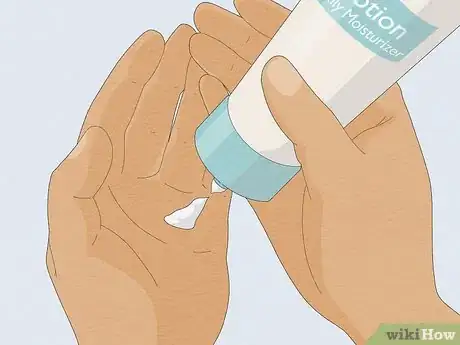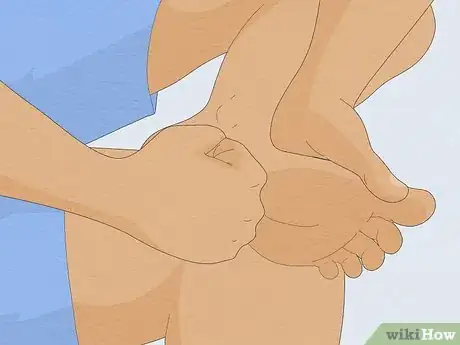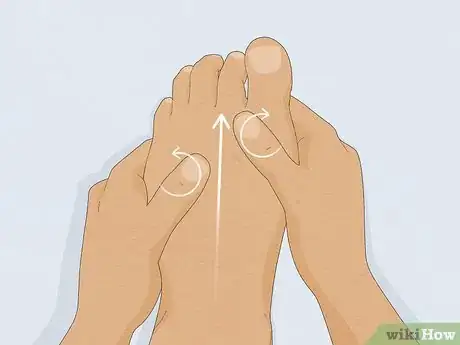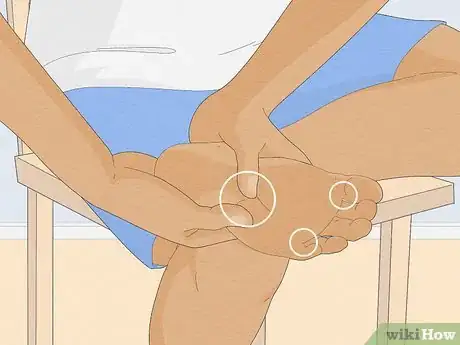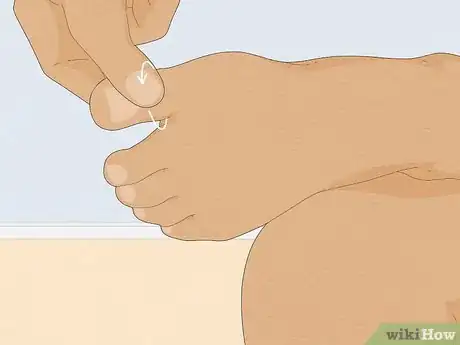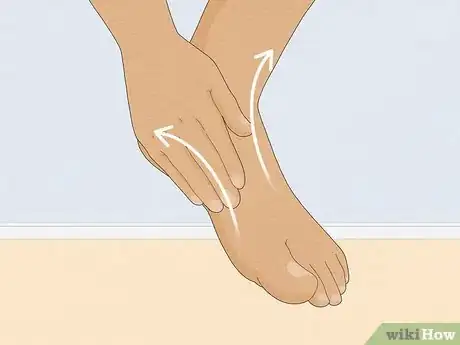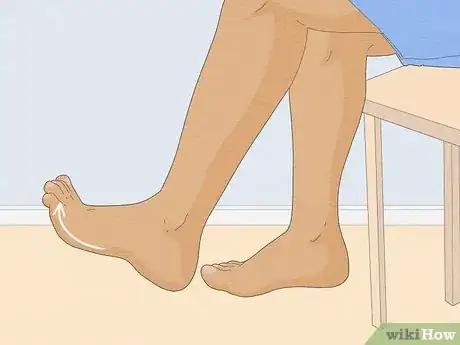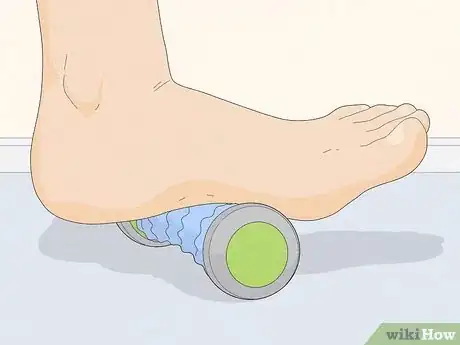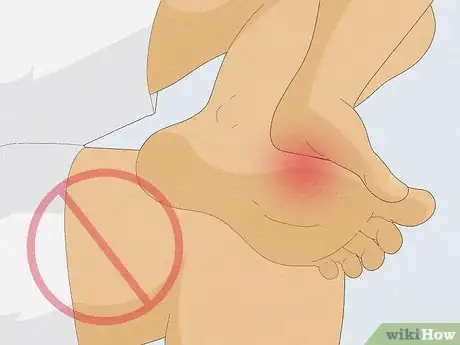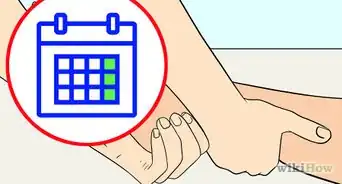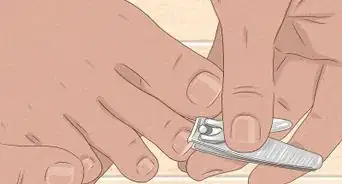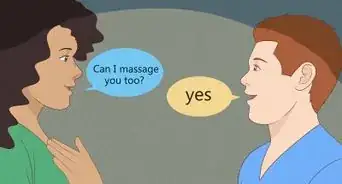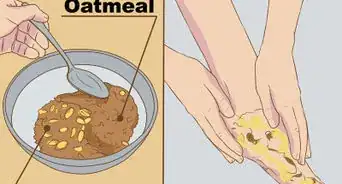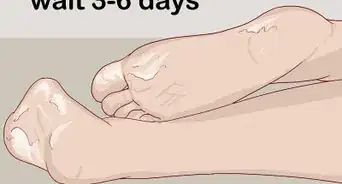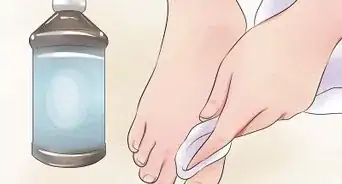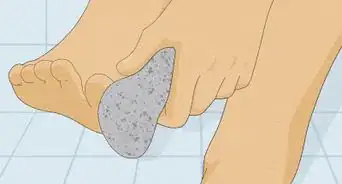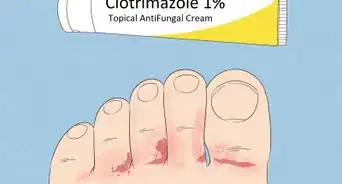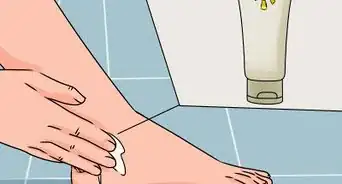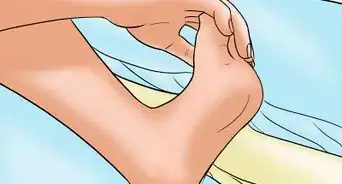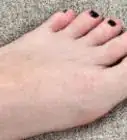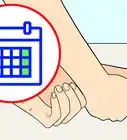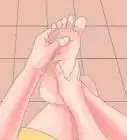This article was co-authored by Neal Blitz, DPM, FACFAS and by wikiHow staff writer, Megaera Lorenz, PhD. Dr. Neal Blitz is a Podiatrist and Foot & Ankle Surgeon who runs private practices in New York City and in Beverly Hills, California. Dr. Blitz is “The Bunion King®” and is the creator of the Bunionplasty® Procedure (plastic surgery for bunions) which has revolutionized bunion surgery. He has over 17 years of podiatric experience and specializes in minimally invasive foot and ankle surgery. Dr. Blitz received his DPM from the New York College of Podiatric Medicine, then completed a residency focused on Elective & Reconstructive Foot & Ankle Surgery at the Swedish Medical Center, and was awarded an AO Trauma fellowship in Dresden, Germany, focused on trauma and reconstructive techniques. He is board certified in Foot Surgery and Reconstructive Rearfoot & Ankle Surgery and is also a Diplomate of the American Board of Foot & Ankle Surgery and a fellow of the American College of Foot & Ankle Surgeons (FACFAS).
There are 17 references cited in this article, which can be found at the bottom of the page.
This article has been viewed 46,875 times.
If your feet are feeling stiff and sore, giving yourself a foot massage is a fast and easy way to get relief. And you don't have to be a professional massage therapist—even the most basic DIY foot massage will help warm up your aching muscles. Massaging your feet can also help ease your stress and reduce swelling due to fluid buildup (edema) in your feet. Read on to learn a few simple techniques to get your aching feet feeling better in no time!
Steps
Community Q&A
-
QuestionWhat if my feet don't smell good?
 wikiHow Staff EditorThis answer was written by one of our trained team of researchers who validated it for accuracy and comprehensiveness.
wikiHow Staff EditorThis answer was written by one of our trained team of researchers who validated it for accuracy and comprehensiveness.
Staff Answer wikiHow Staff EditorStaff AnswerWash your feet with soap and water before you massage them to get rid of odors. You can also sprinkle on some baby powder or foot powder to help your feet smell fresh and reduce friction during the massage.
wikiHow Staff EditorStaff AnswerWash your feet with soap and water before you massage them to get rid of odors. You can also sprinkle on some baby powder or foot powder to help your feet smell fresh and reduce friction during the massage. -
QuestionWhy do we get massages?
 wikiHow Staff EditorThis answer was written by one of our trained team of researchers who validated it for accuracy and comprehensiveness.
wikiHow Staff EditorThis answer was written by one of our trained team of researchers who validated it for accuracy and comprehensiveness.
Staff Answer wikiHow Staff EditorStaff AnswerMassage can help reduce tension, promote relaxation, and improve your circulation. It's a great way to relieve pain and stiffness in your muscles and joints. Some massage techniques can also help reduce swelling and fluid retention.
wikiHow Staff EditorStaff AnswerMassage can help reduce tension, promote relaxation, and improve your circulation. It's a great way to relieve pain and stiffness in your muscles and joints. Some massage techniques can also help reduce swelling and fluid retention.
References
- ↑ https://www.health.harvard.edu/mind-and-mood/foot-massage-the-pause-that-refreshes-and-it-good-for-you
- ↑ https://www.health.harvard.edu/mind-and-mood/foot-massage-the-pause-that-refreshes-and-it-good-for-you
- ↑ https://www.piedmont.org/living-better/how-to-give-yourself-a-massage
- ↑ https://www.health.harvard.edu/mind-and-mood/foot-massage-the-pause-that-refreshes-and-it-good-for-you
- ↑ https://www.drugs.com/cg/how-to-give-a-foot-massage.html
- ↑ https://www.piedmont.org/living-better/how-to-give-yourself-a-massage
- ↑ https://www.painscience.com/articles/spot-10-foot-arch.php
- ↑ https://www.painscience.com/articles/spot-10-foot-arch.php
- ↑ https://www.painscience.com/articles/spot-10-foot-arch.php
- ↑ https://www.today.com/health/how-give-yourself-one-heck-killer-massage-t74581
- ↑ https://www.drugs.com/cg/how-to-give-a-foot-massage.html
- ↑ https://www.womensrunning.com/health/physical-therapist-massage-feet/
- ↑ https://www.mayoclinic.org/diseases-conditions/plantar-fasciitis/diagnosis-treatment/drc-20354851
- ↑ https://www.mayoclinic.org/diseases-conditions/edema/diagnosis-treatment/drc-20366532
- ↑ https://www.uhn.ca/PatientsFamilies/Health_Information/Health_Topics/Documents/How_to_Do_Self_Lymphatic_Massage_Lower_Body.pdf
- ↑ https://www.gwh.nhs.uk/media/186168/foot-and-ankle-exercises.pdf
- ↑ Neal Blitz, DPM, FACFAS. Board Certified Podiatrist. Expert Interview. 22 April 2020.
- ↑ Neal Blitz, DPM, FACFAS. Board Certified Podiatrist. Expert Interview. 22 April 2020.
- ↑ Neal Blitz, DPM, FACFAS. Board Certified Podiatrist. Expert Interview. 22 April 2020.
- ↑ https://www.highgatehospital.co.uk/gp-news/nine-exercises-to-relieve-foot-and-ankle-pain/
- ↑ https://health.uconn.edu/orthopedics-sports-medicine/2017/08/01/three-exercises-plantar-fasciitis/
- ↑ https://www.womensrunning.com/health/physical-therapist-massage-feet/
- ↑ https://www.piedmont.org/living-better/how-to-give-yourself-a-massage
- ↑ https://www.ortho.wustl.edu/content/Education/3691/Patient-Education/Educational-Materials/Plantar-Fasciitis-Exercises.aspx
- ↑ https://www.health.harvard.edu/mind-and-mood/foot-massage-the-pause-that-refreshes-and-it-good-for-you
- ↑ https://www.aafp.org/afp/1999/0901/p1002.html
- ↑ https://www.uhn.ca/PatientsFamilies/Health_Information/Health_Topics/Documents/How_to_Do_Self_Lymphatic_Massage_Lower_Body.pdf
- ↑ https://www.health.harvard.edu/healthbeat/7-ways-to-fix-foot-pain
- ↑ https://www.takingcharge.csh.umn.edu/explore-healing-practices/reflexology/are-there-times-when-i-shouldn-t-have-reflexology
- ↑ https://www.takingcharge.csh.umn.edu/explore-healing-practices/reflexology/are-there-times-when-i-shouldn-t-have-reflexology
- ↑ https://www.takingcharge.csh.umn.edu/explore-healing-practices/reflexology/are-there-times-when-i-shouldn-t-have-reflexology

